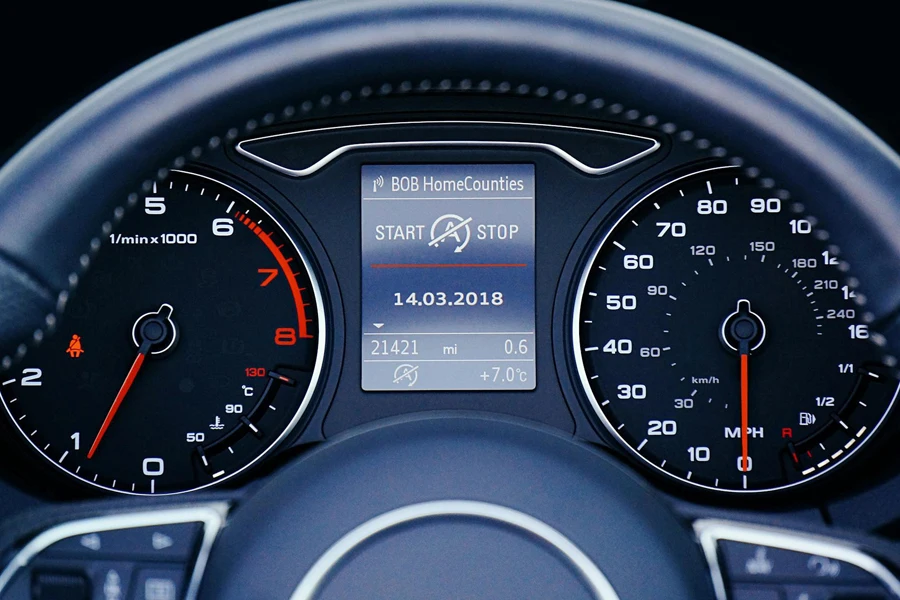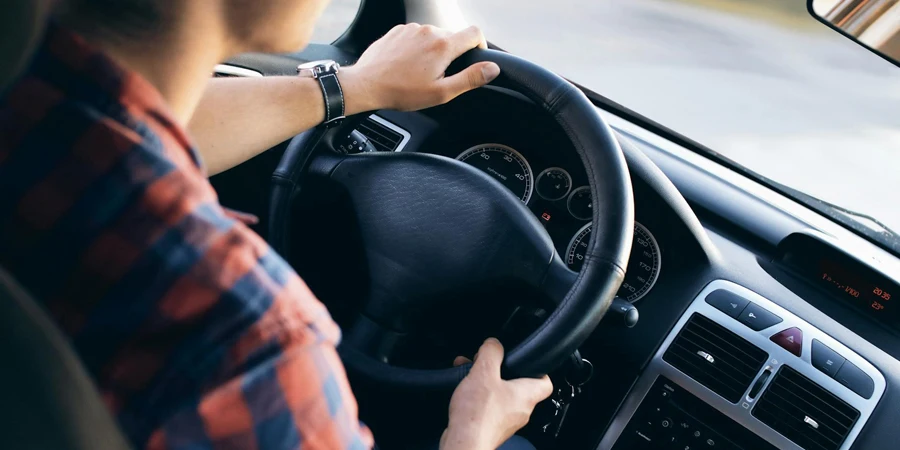Daftar Isi
● Pendahuluan
● Tinjauan pasar
● Berbagai jenis roda kemudi mobil
● Hal-hal yang perlu dipertimbangkan ketika memilih produk
● Kesimpulan
Pengantar
Evolusi roda kemudi mobil telah mengubah pengalaman berkendara, menawarkan fungsionalitas canggih dan peningkatan ergonomis untuk memenuhi beragam kebutuhan berkendara. Roda kemudi modern kini mengintegrasikan berbagai fitur seperti cruise control, kontrol audio, dan mekanisme keselamatan canggih, sehingga meningkatkan kenyamanan dan keselamatan. Pasar roda kemudi otomotif semakin berkembang didorong oleh kemajuan teknologi dan meningkatnya permintaan akan kemewahan dan kenyamanan pada kendaraan. Berbagai jenis roda kemudi, dari stok hingga balap dan vintage, memenuhi berbagai preferensi dan gaya mengemudi. Memilih roda kemudi yang tepat melibatkan pertimbangan faktor-faktor seperti pola baut, diameter, bentuk, dan kualitas bahan.
Gambaran pasar

Skala dan pertumbuhan pasar
Pasar roda kemudi otomotif global saat ini bernilai USD 28.22 miliar dan diproyeksikan mencapai USD 36.83 miliar selama lima tahun ke depan, tumbuh pada tingkat pertumbuhan tahunan gabungan (CAGR) sebesar 4.53%. Pertumbuhan ini didorong oleh meningkatnya permintaan kendaraan penumpang, terutama di negara-negara berkembang, di mana peningkatan pendapatan yang dapat dibelanjakan dan permintaan konsumen akan perjalanan mewah dan nyaman merupakan faktor yang signifikan. Integrasi fitur-fitur canggih seperti kontrol multi-fungsi dan mekanisme keselamatan yang ditingkatkan ke dalam roda kemudi juga berkontribusi terhadap perluasan pasar.
Wawasan daerah
Asia Pasifik mendominasi pasar roda kemudi otomotif, memegang pangsa pasar terbesar dan paling cepat berkembang. Faktor-faktor seperti urbanisasi yang pesat, meningkatnya pendapatan yang dapat dibelanjakan, dan berkembangnya industri otomotif di negara-negara seperti Tiongkok, India, Jepang, dan Korea Selatan mendorong pertumbuhan ini. Penerapan sistem electric power steering (EPS) pada mobil penumpang patut mendapat perhatian khusus di Jepang, karena sistem ini menawarkan keuntungan seperti pengurangan biaya perbaikan dan pemeliharaan. Selain itu, ketersediaan bahan baku berbiaya rendah, tenaga kerja murah, dan inisiatif pemerintah yang mendukung semakin memperkuat posisi pasar di kawasan ini.
Berbagai jenis roda kemudi

Roda kemudi stok
Roda kemudi stok adalah perlengkapan standar pada kendaraan baru, dirancang untuk kenyamanan dan kemudahan penggunaan. Roda ini biasanya dilengkapi dengan fitur-fitur penting seperti airbag dan tombol kontrol untuk audio dan cruise control. Desainnya yang unik menarik bagi rata-rata pembeli mobil, memberikan perpaduan yang seimbang antara fungsionalitas dan keselamatan. Integrasi sistem elektronik memungkinkan adanya multifungsi, di mana pengemudi dapat mengendalikan berbagai aspek kendaraan tanpa melepaskan tangan dari kemudi. Roda ini dirancang untuk mematuhi peraturan keselamatan yang ketat, memastikan kantung udara dan kontrol elektronik bekerja dengan lancar.
Roda kemudi sport
Roda kemudi sport dirancang untuk pengemudi yang menginginkan kontrol yang lebih baik dan pengalaman berkendara yang lebih responsif. Roda ini biasanya berdiameter lebih kecil, biasanya sekitar 13 hingga 14 inci, memungkinkan belokan lebih cepat dan presisi. Desain ergonomis dengan pegangan berkontur meningkatkan kenyamanan dan kontrol pengemudi selama berkendara agresif. Banyak roda kemudi sport memiliki bagian bawah datar untuk memberikan ruang kaki tambahan dan memudahkan masuk dan keluar. Dibangun dari bahan ringan seperti aluminium dan dibalut bahan dengan daya cengkeram tinggi seperti kulit atau Alcantara, velg ini dirancang untuk meningkatkan estetika dan performa kendaraan.
Roda kemudi klasik/vintage
Roda kemudi klasik atau vintage meniru desain asli yang ditemukan pada kendaraan lama, sering kali menggunakan bahan seperti kayu dan krom yang dipoles. Roda ini ideal untuk mempertahankan tampilan dan nuansa asli mobil antik. Mereka menampilkan detail yang rumit dan pengerjaan berkualitas baik, termasuk pelek kayu terpaku dan jari-jari yang dipoles, menjadikannya pilihan yang dicari oleh pemulih mobil dan pemilik mobil klasik. Roda ini biasanya memiliki diameter lebih besar, sekitar 15 hingga 16 inci, memberikan pengalaman berkendara nostalgia yang mengingatkan kita pada era awal otomotif. Meskipun berpenampilan klasik, banyak yang dirancang untuk memenuhi standar keselamatan modern.
Roda kemudi balap
Roda kemudi balap dirancang khusus untuk performa berkendara dan penggunaan trek. Roda ini ringan, sering kali terbuat dari bahan seperti serat karbon atau aluminium, dan dilengkapi dengan mekanisme pelepasan cepat untuk pelepasan dan pemasangan kembali dengan cepat. Fitur ini sangat berguna dalam skenario motorsport di mana setiap detik sangat berarti. Desain piringan dalam mendekatkan roda kemudi ke pengemudi, memungkinkan masukan kemudi lebih langsung dan pengendalian lebih baik. Banyak roda kemudi balap dilengkapi fitur seperti jari-jari yang dibor untuk mengurangi bobot dan titik pemasangan untuk kontrol sistem kinerja seperti nitrous atau line lock, menawarkan pengalaman berkendara yang sentuhan dan responsif.
Jenis khusus
Roda kemudi khusus memenuhi kebutuhan dan preferensi spesifik. Roda kemudi yang dapat dimiringkan dapat disetel ke atas dan ke bawah untuk mengakomodasi berbagai posisi berkendara, sehingga meningkatkan kenyamanan dan aksesibilitas. Roda kemudi ayun dapat dipindahkan menjauh dari pengemudi untuk memudahkan masuk dan keluar, pertama kali diperkenalkan pada model seperti Ford Thunderbird tahun 1961. Roda kemudi teleskopik dapat disesuaikan dalam rentang tertentu agar sesuai dengan ketinggian pengemudi yang berbeda, memberikan pengalaman berkendara yang disesuaikan. Roda kemudi berbentuk D, terinspirasi oleh mobil balap, memiliki fitur bagian bawah yang datar untuk memberikan ruang kaki yang lebih luas dan pandangan yang lebih baik ke kluster instrumen. Roda kemudi pelepas cepat mudah dilepas jika terjadi keadaan darurat, biasanya digunakan pada kendaraan performa dan balap untuk memudahkan keluar dengan cepat jika terjadi kecelakaan. Masing-masing desain ini mengintegrasikan fitur ergonomis dan keselamatan khusus untuk meningkatkan pengalaman berkendara.
Hal-hal yang perlu diperhatikan dalam memilih produk

Pola baut
Saat memilih roda kemudi, pola baut merupakan faktor penting. Pola baut, ditentukan oleh jumlah lubang pemasangan dan susunannya pada hub roda kemudi, harus sesuai dengan desain kolom kemudi agar terpasang dengan aman. Pola umum mencakup desain 3 baut dan 6 baut. Jika ada ketidakcocokan, adaptor mungkin diperlukan. Adaptor tidak hanya memastikan pemasangan yang tepat tetapi juga menjaga integritas struktural sambungan kemudi, yang penting untuk keselamatan dan kinerja.
Diameter
Diameter roda kemudi berdampak signifikan terhadap dinamika kemudi dan ergonomi pengemudi. Roda yang lebih kecil, biasanya berdiameter antara 13 hingga 14 inci, mengurangi jarak rotasi yang diperlukan untuk input kemudi, meningkatkan respons dan kontrol, terutama dalam skenario performa dan balap. Roda yang lebih kecil ini memerlukan masukan yang lebih presisi, ideal untuk manuver kecepatan tinggi. Roda yang lebih besar, sekitar 15 hingga 16 inci, menawarkan cengkeraman yang lebih santai dan nyaman, cocok untuk berkendara jarak jauh dan kendaraan besar yang mengutamakan leverage dan kemudahan kemudi. Pemilihan diameter harus mempertimbangkan tujuan penggunaan kendaraan dan kebutuhan kenyamanan pengemudi.
Bentuknya
Bentuk roda kemudi dapat mempengaruhi estetika dan fungsionalitas. Roda bundar tradisional bersifat serbaguna, memberikan kontrol seragam ke segala arah. Roda berbentuk D atau bagian bawah datar dirancang untuk memberikan ruang kaki tambahan dan memudahkan masuk dan keluar, terutama bermanfaat pada mobil sport. Bentuk-bentuk ini juga memberikan isyarat visual untuk orientasi roda, yang sangat penting selama berkendara dengan performa tinggi. Desain ergonomis dengan pegangan berkontur atau sandaran ibu jari dapat mengurangi kelelahan selama penggunaan jangka panjang dan meningkatkan presisi penanganan. Mengevaluasi bentuknya melibatkan keseimbangan kenyamanan pengemudi, ruang interior, dan dinamika berkendara kendaraan.
Hidangan
Piringan roda kemudi, atau jarak offset dari permukaan pemasangan ke pegangan roda, mempengaruhi jangkauan pengemudi dan postur mengemudi. Piringan yang lebih dalam, mendekatkan roda ke pengemudi, dapat meningkatkan kenyamanan dan pengendalian dengan mengurangi jarak jangkauan, yang penting dalam balap dan aplikasi performa tinggi. Konfigurasi ini mendukung posisi mengemudi yang lebih tegak dan aktif, meningkatkan kemampuan manuver dan umpan balik. Sebaliknya, piringan yang dangkal atau datar akan mendorong roda lebih jauh, yang mungkin lebih disukai pada kendaraan dengan ruang kabin terbatas atau bagi pengemudi yang menginginkan posisi lengan lebih panjang. Pilihan antena piringan harus selaras dengan preferensi ergonomis pengemudi dan tata letak interior kendaraan.
Bahan dan kualitas bangunan
Bahan dan kualitas pembuatan roda kemudi sangat penting untuk daya tahan, umpan balik sentuhan, dan keselamatan. Bahan umum termasuk kulit bermutu tinggi, yang dikenal nyaman digenggam dan tahan lama; Alcantara, yang menawarkan cengkeraman superior dan kesan mewah; dan kayu atau logam yang dipoles, untuk estetika vintage. Struktur internal, seringkali terdiri dari baja atau aluminium, harus tahan terhadap tekanan dan gaya puntir yang signifikan. Konstruksi berkualitas baik memastikan roda tetap mempertahankan integritasnya dalam kondisi ekstrem, mencegah deformasi atau kegagalan. Teknik manufaktur tingkat lanjut, seperti pemesinan CNC dan pengelasan presisi, berkontribusi pada kekokohan dan umur panjang roda kemudi.
Pertimbangan hukum dan keamanan
Pertimbangan hukum dan keselamatan adalah hal yang terpenting ketika memilih roda kemudi, terutama untuk kendaraan yang awalnya dilengkapi airbag. Penting untuk memastikan bahwa roda kemudi baru kompatibel dengan sistem airbag kendaraan, karena melepas atau menonaktifkan airbag dapat melanggar peraturan keselamatan federal dan lokal. Kompatibilitas ini biasanya memerlukan pemilihan roda yang dapat mengakomodasi modul airbag dan kabel terkait. Selain itu, kepatuhan terhadap peraturan mengenai modifikasi roda kemudi sangat penting untuk menjaga kelaikan jalan kendaraan. Pemasangan yang benar oleh teknisi yang berkualifikasi direkomendasikan untuk memastikan bahwa semua fitur keselamatan tetap dipertahankan dan berfungsi, memberikan perlindungan yang diperlukan bagi penghuninya.
Kesimpulan

Memilih roda kemudi yang tepat sangat penting untuk meningkatkan pengalaman berkendara dan estetika kendaraan. Dengan memahami tren pasar, berbagai jenis roda kemudi, dan kriteria pemilihan utama seperti pola baut, diameter, bentuk, antena piringan, kualitas bahan, dan pertimbangan hukum, bisnis dapat membuat keputusan berdasarkan informasi yang memenuhi kebutuhan spesifik mereka. Pendekatan yang terinformasi ini memastikan kinerja, kenyamanan, dan keamanan yang optimal, yang pada akhirnya berkontribusi terhadap kepuasan dan efisiensi kendaraan secara keseluruhan.




